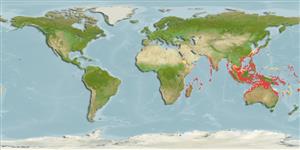>
Gobiiformes (Gobies) >
Gobiidae (Gobies) > Gobiinae
Etymology: Pleurosicya: Greek, pleura = side, ribe + Greek, sikya, -as = cucumber (Ref. 45335).
Eponymy: Lieutenant Helenus Johannes Boldingh (1868–1954) was one of three officers aboard the Dutch ‘HMS Siboga’ expedition (1899–1900) to the East Indies, led by Weber (q. [...] (Ref. 128868), visit book page.
More on author: Weber.
Environment: milieu / climate zone / depth range / distribution range
Ökologie
seewasser riff-verbunden; tiefenbereich 5 - 82 m (Ref. 90102). Tropical
Indo-West Pacific: East Africa to Solomon Islands; Japan to Western Australia.
Size / Gewicht / Alter
Maturity: Lm ? range ? - ? cm
Max length : 4.5 cm SL Männchen/unbestimmt; (Ref. 48637)
Rückenflossenstacheln (insgesamt) : 6 - 7; Rückenflossenweichstrahlen (insgesamt) : 7; Afterflossenstacheln: 1; Afterflossenweichstrahlen: 6 - 8. Characterized by semi-translucent body and fins, blend s well with soft coral or seapen; nape usually scaled to behind eyes; longitudinal scale series 22-25; wide gill opening, reaching forward to below posterior edge of eye; relatively deep bodied, depth of body at anus 3.8-5.8 in SL (Ref. 90102).
Lives on Dendronephthya soft corals, usually at depth of 20 meters or more in areas subject to strong currents. Large corals may play host to several individuals (Ref. 48637). Also found with Sarcophyton soft corals and sea pens in 5-82 m (Ref 90102).
Life cycle and mating behavior
Geschlechtsreife | Fortpflanzung | Ablaichen | Eier | Fecundity | Larven
Heemstra, P.C., 1995. Additions and corrections for the 1995 impression. p. v-xv. In M.M. Smith and P.C. Heemstra (eds.) Revised Edition of Smiths' Sea Fishes. Springer-Verlag, Berlin. (Ref. 11228)
IUCN Rote Liste Status (Ref. 130435: Version 2024-2)
Bedrohung für Menschen
Harmless
Nutzung durch Menschen
Tools
Zusatzinformationen
Download XML
Internet Quellen
Estimates based on models
Preferred temperature (Ref.
123201): 23.6 - 28.9, mean 27.5 °C (based on 672 cells).
Phylogenetic diversity index (Ref.
82804): PD
50 = 0.5000 [Uniqueness, from 0.5 = low to 2.0 = high].
Bayesian length-weight: a=0.00724 (0.00339 - 0.01546), b=3.10 (2.92 - 3.28), in cm total length, based on LWR estimates for this (Sub)family-body shape (Ref.
93245).
Trophic level (Ref.
69278): 3.2 ±0.3 se; based on size and trophs of closest relatives
Widerstandsfähigkeit (Ref.
120179): hoch, Verdopplung der Population dauert weniger als 15 Monate. (Preliminary K or Fecundity.).
Fishing Vulnerability (Ref.
59153): Low vulnerability (10 of 100).
